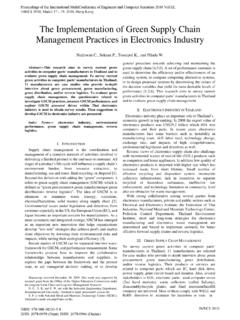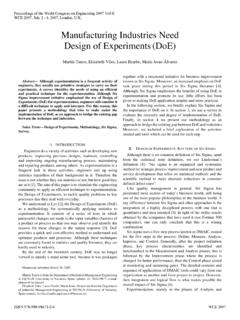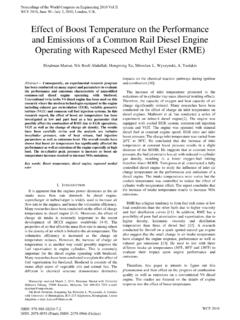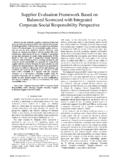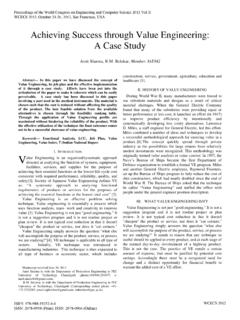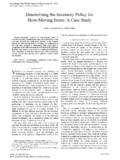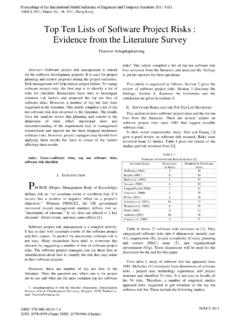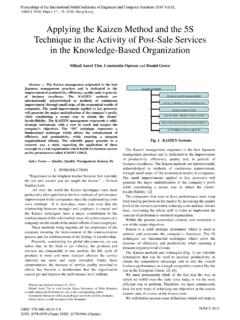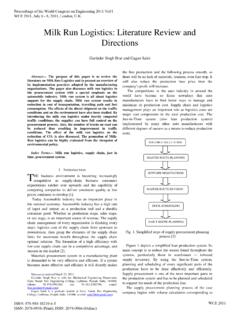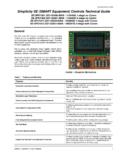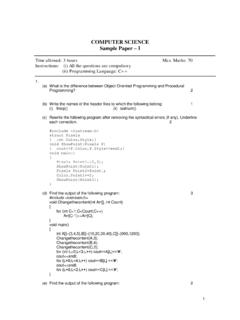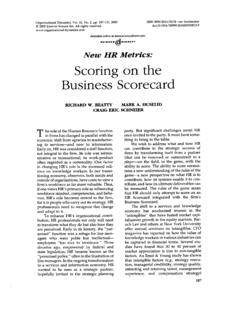Transcription of Stress Relief Cracking in Advanced Steel Material- Overview
1 Abstract This paper summarizes the quality problems of the weldability of Advanced vanadium modified Cr, Mo alloy Steel material , during fabrication of reactor, pressure vessel being used for Refinery, Petrochemical, Chemical plants. Authors have focused on Stress Relief Cracking occurred in weld metal and HAZ after Stress relieving heat treatment of the weld. From the literature review , it appears that till date significant amount of efforts are made to understand the Stress Relief Cracking , occurring in alloy Steel .However considerable work is still being done on this quality issue to understand root cause of Stress Relief Cracking and remedy to prevent it. Key words: Cr, Mo, V alloy Steel , Stress Relief Crack, Molybdenum carbide, Vanadium carbide I. INTRODUCTION In refinery, reactors and pressure vessels are required primarily either for desulpherisation of hydrocarbon or Cracking heavier hydrocarbon to lighter molecules.
2 This process is carried out at high design temperature (450 C) and pressure (100 kg/cm2) under hydrogen environment in presence of catalyst. Alloy steels are being used to withstand against high temperature and pressure and improvements are made in alloy steels to meet requirements .5th generation Steel in form of vanadium modified Cr, Mo alloy is used in 1995 for the first time. Looking at the present need in refinery and process criticality, equipment with large wall thickness either in plate or forging form are manufactured. to % Chrome molybdenum alloys used for the reactor, way back in 1920 in Germany[8] for the hydrogenation plant operating at pressure range of 28 to 70 MPa and was considered as first generation Steel . 2nd generation Steel : Mid 1960s to 1970s-Modern hydro processing reactors manufactured using modified -1Mo alloy with improved toughness property of 54 J at 10 C.
3 No considerations were made for the temper embrittlement control. 3rd generation Steel : 1970s to 1980s- Controls over impurities was emphasized and J factor was restricted to 180 to control temper embrittlement .Toughness was further improved to 54 J at -18 C. Step cooling test was also introduced with hydrogen disbanding test over weld overlay. S P Ghiya: M Tech (Research) Scholar, student Sardar Vallabhbhai National Institute Technology, (SVNIT), Surat (email: / ) D V Bhatt, Professor (RIL), Mechanical Engineering Department, SVNIT, Surat. (email: ) R V Rao, Professor and Head of Mechanical Engineering Department, SVNIT, Surat (email: ) 4th generation Steel : 1980s to 1990s - Improved temper embrittlement characteristics by restricting J factor up to 100.
4 Toughness property further improved to 54 J at -32 C. Presently 5th generation Steel is in use. Mid 1990s onwards Advanced Chromium and 1% Molybdenum Steel with improved toughness up to 54 J at -40 C is developed. Additionally Cr, 1Mo and material with improved following properties were developed by leading Steel suppliers. High tensile property at elevated temperature Toughness at 54J at -29 C Increased hydrogen attack resistance Enhanced creep resistance property Lower susceptibility to hydrogen disbonding Apart from welding, Cracking during services due to reheat, or relaxation , Cracking or failure during the shut down or repair welding due to service embrittlement of heat resistant materials remains great practical concern in the Power generation, Refinery and Petrochemical industry.
5 [8] II. REACTOR STEELS: CONVENTIONAL CR-MO AND V MODIFIED CR-MO: Primarily three modified alloys 1) , 2) & 3) [14] utilize vanadium addition to enhance tensile strength at elevated temperature and creep rupture strength and to improve resistance to in-service degradation phenomena, such as temper embrittlement, high temperature hydrogen attack (HTHA) and hydrogen embrittlement. Design properties of the conventional Cr-Mo Steel and vanadium modified Cr-Mo steels are summarized in room temperature strength properties of the modified steels are presented. Increased mechanical properties allow for higher design stresses, leading to a decreased wall thickness and reduced weight of reactors. According to API 941, wt% of vanadium in Cr-1Mo Steel protects the material from HTHA under partial pressure less than or equal to MPa up to 482 C 454 C for the conventional %Cr-1 Mo alloy.
6 However despite the vanadium addition, the maximum design temperature permitted by ASME SEC VIII-2 for modified 3Cr-1Mo Steel is 454 C at the present time. These steels can not meet design requirements of ASME SEC VIII-2 creep rupture requirements at 482 C. It is seen from the Table-1 that application of the modified steels results in lower unit weight of the reactors. III. Stress Relief Cracking Reheat Cracking in welded structure has received considerable attention since mid 1950s primarily with austenitic steels used for power generating equipment for Stress Relief Cracking in Advanced Steel material - Overview S P Ghiya , D V Bhatt , R V Rao Proceedings of the World Congress on Engineering 2009 Vol IIWCE 2009, July 1 - 3, 2009, London, :978-988-18210-1-0 WCE 2009 high temperature steam piping.
7 In early 1960s similar Cracking problem during Stress Relief heat treatments and high temperature service were again observed where ferritic creep resisting 2 CrMo and CrMoV weldments in steam pipe work were found to exhibit occasional Cracking . [1] Reheat Cracking may occur in low alloy steels containing additions of chromium and vanadium or chromium, molybdenum and vanadium when the welded component is being subjected to post weld heat treatment such as Stress Relief heat treatment. Reheat Cracking is kind of intergranular Cracking in the HAZ or weld metal occurs during the Stress Relief heat treatment or during service at high temperature. This phenomenon happens largely with alloy Steel with Cr, Mo, V alloy. An explanation, perhaps widely accepted, to reheat Cracking is significant reduction in grain-boundary ductility during Stress Relief cycle or service due to either segregation of trace impurities or precipitation of carbides.
8 The reduction in ductility, perhaps, to an extent that it is insufficient to accommodate the plastic deformation associated with Stress relaxation. [5] Stress Relief crack may occur either on HAZ or within weld metal which will be detected either visually or by performing additional NDT testing like magnetic particle testing or ultrasonic testing methods. IV. VISUAL APPEARANCE: Fig: 1 `Location of reheat crack in reactor As shown in Fig:-1 , Cracking is found primarily in the coarse grained regions of the heat affected zone, beneath the weld, or cladding, and in the coarse grained regions with in the weld metal. The cracks can often be seen visually, usually associated with areas of Stress concentration such as weld toe. A macro-crack will appear as a rough crack, often with branching, following the coarse grain region.
9 Cracking is always intergranular along prior austenite grain boundaries as shown in Fig:-2. Macro cracks in the weld metal can be oriented either longitudinal or transverse direction of welding. Crack in the HAZ is always parallel to the direction of welding. The characteristic features and principal causes of reheat Cracking are described. General guidelines on best practice are developed so that welders can minimize the risk of reheat Cracking in welded fabrications. Table:1 Comparison of reactor Steel conventional Cr - Mo and V modified Cr - Mo Steel grade Conventional Conventional 3Cr -1Mo Max. allowed temperature ASME VIII-2 482 C 482 C 454 C 454C 454 C Max. allowed temperature API 941 454 C 510 C 510 C 510 C 510 C Min. Tensile strength 517 MPa 586 MPa 517 MPa 586 MPa 586 MPa Min.
10 Yield strength 310 MPa 414 MPa 310 MPa 414 MPa 414 MPa at 454 C 150 MPa at 454 C 169 MPa at 454 C 131 MPa at 454 C164 MPa at 454 C 164 MPa Design Stress intensity value at 482 C 117 MPa at 482 C 163 MPa .. at 454 C 338 MPa at 454 C 298 MPa at 454 C 392 MPa at 454 C 307 MPa at 454 C 307 MPa wall thickness [1] at 482 C 442 Mpa at 482 C 310 MPa .. 454 Cdesign: reactor weight 1038 metric tons 916 metric tons 1203 metric tons 944 metric tons 944 metric tons 482 C design : reactor weight typical 1359 metric tons 953 metric tons .. Proceedings of the World Congress on Engineering 2009 Vol IIWCE 2009, July 1 - 3, 2009, London, :978-988-18210-1-0 WCE 2009 Fig: 2, Intergranular morphology of reheat cracks in weld V. GENERATION OF Stress Relief Cracking : Many papers are published on Stress Relief Cracking in the past and most of these papers are related with HAZ and very few papers on weld metal.
